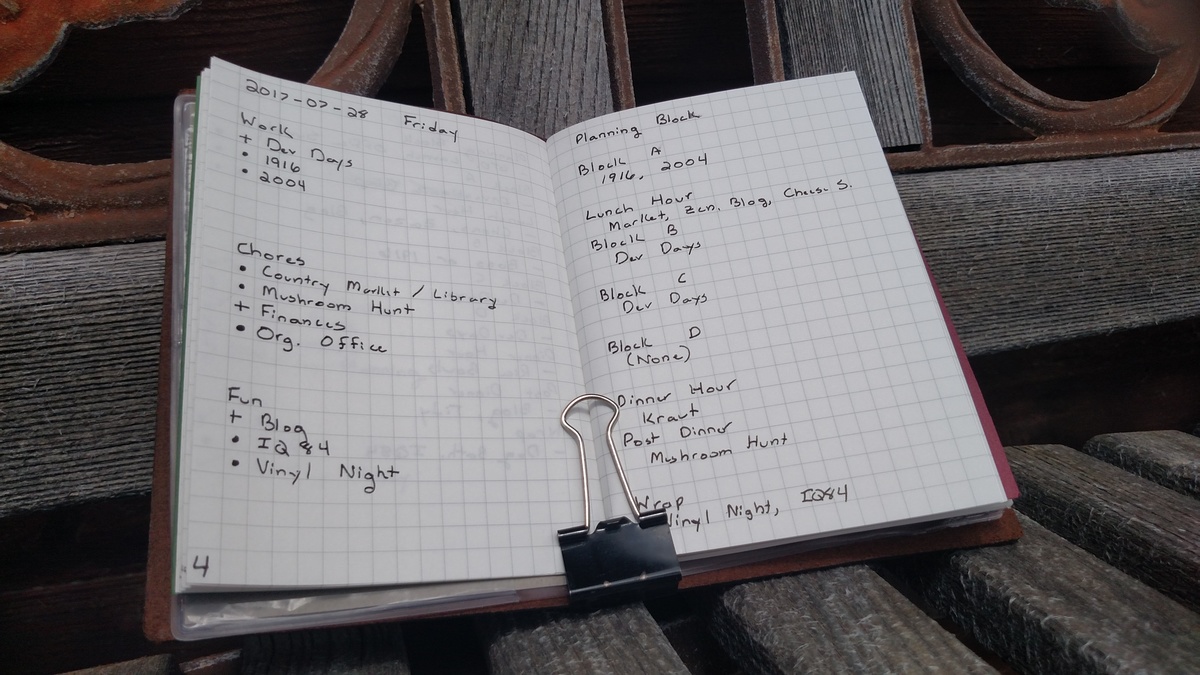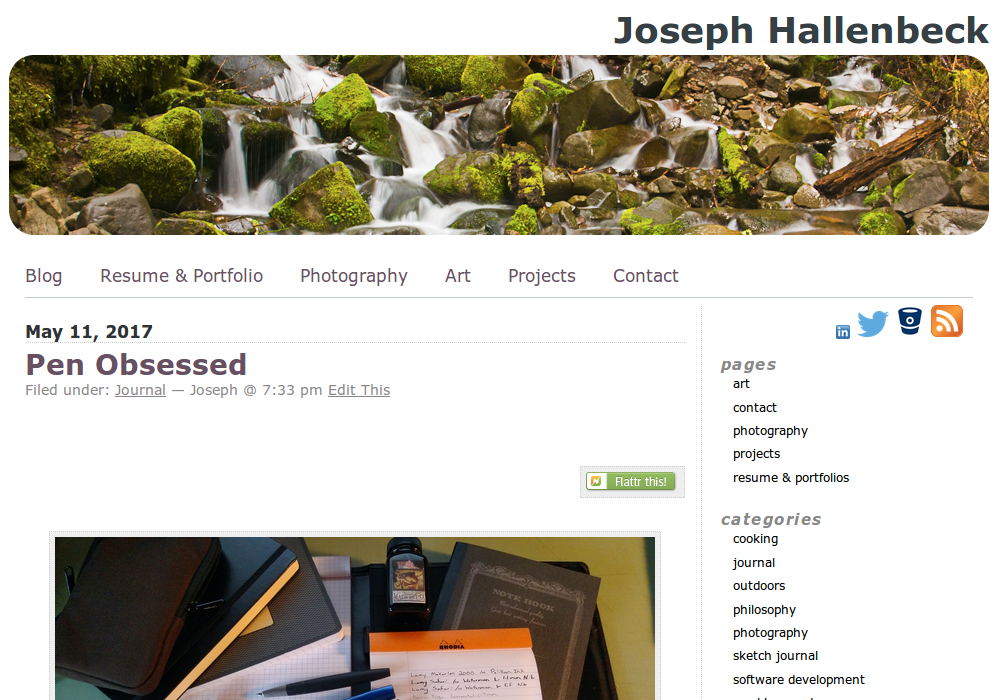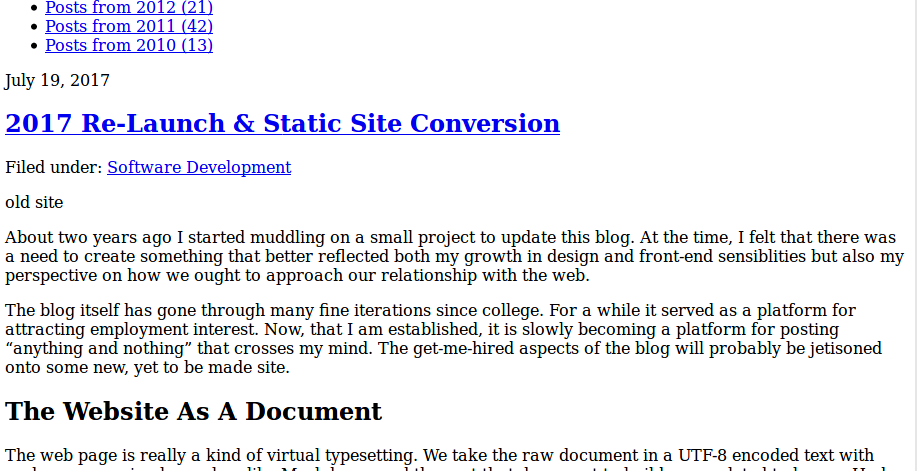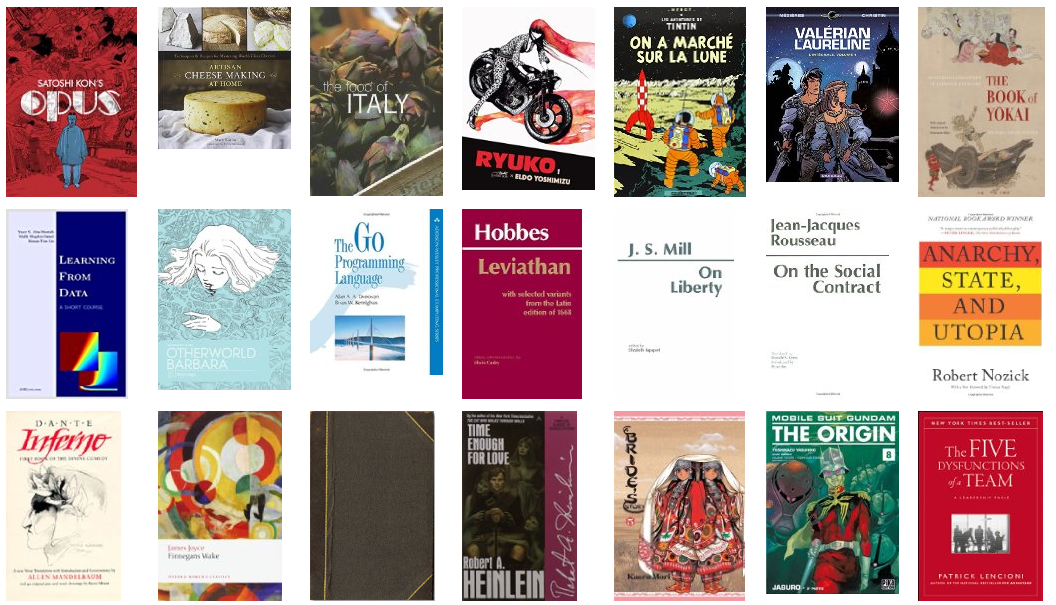If Goodbye Trello, Hello Todo.txt didn’t reveal my roots as a day-planner
fanatic then I’m sure this post will.
This week, I sadly retire the Franklin Planner that has been by my side for the
last twelve years. I never really followed the Franklin method, and over time my
personal day planning strategy has relied less and less upon it’s features. The
notes pages were never quite large enough to fit the reams of notes that I need
for my work. The hourly planning lacked the ability to schedule in twenty-four
blocks (who in this day and age keeps strictly to 9-to-5?). And the hundreds of
detailed todo items, reminders, and recurring calendar events are best rendered
computationally rather than by hand. Over the years,
the Franklin Planner saw less and less use until it eventually become an
afterthought to my daily planning regiment.
As of late, I have been trying to consider alternative solutions to GTD in order
to get a more fluid style of day planning that respects the flexibility in time
scheduling and necessity of play in creative work. The rigidity of keeping to a
fixed hourly schedule, and a general movement towards a kind of fixed daily
routine, has left me thinking of my time less in hours and more as four to five
work blocks; an hour for breakfast, lunch, dinner, and bed respectively; and a
single block of after-dinner time for creative or cultural pursuits.
Bullet Journaling
My attention has turned Bullet Journaling as a planning method that
incorporates a the kind of looseness and play that I am looking for in my
planning. The Bullet Journal does not replace the todo.txt cli, but rather
augments it. A large part of my day is routine and need not be recorded other
than to generate an automatic reminder and be marked done. There are perhaps
twenty to thirty items each day, varying by day of week or time of month that
appear magically in my todo list. Likewise, managing my backlog of some three
hundred house chores, creative projects, and writing prompts could fill several
hand written journals.
The Midori Traveler’s Notebook

I received, form my birthday, a Midori Traveler’s Notebook. This wonderful,
passport-sized leather notebook solves so many of the Franklin Planner’s
problems: it’s light and pocket sized so I can carry it on me at all times, the
pages are 25-lines high and open to my creative interpretation on how they will
be used, the classic band-bound design allows me to easily store loose sheets of
paper such as receipts or printed and folded shopping lists. Once more, it just
looks and feels great to have in my hands. My passport-sized item has two
bullet-guided notebooks inside (my estimate is that each notebook ought to last
me roughly a month), and I carry a binder clip to hold it open to my schedule
for the work day.
My Method
The method that I am about to describe is highly experimental. Over the next two
months, I am forgoing the Franklin Planner to see if some form of bullet
journaling could take it’s place.
The bullet journaling method needed some adaptation for my usage. First, I am
not attempting to create a journal of all my tasks in a day. Such would merely
be replicating the logging that I get from using Todo.txt. Rather, this is a
birds-eye view of the most important tasks that I want to complete or progress in
the day and a simple layout of those tasks into my block schedule.
The general bullet journal idea of placing a topic on the page with subsequent
sub-items remains and will fill in the side pages. As will an index at the
beginning of each notebook. The small size (remember we have only 25 lines to
work with) of the notebook necessitates brevity and focus on only the most
important items.
Syntax
The bullet journal syntax remains close to the original. We have three types of
items: a task, an event, and a note. I add to this, the project which is a kind
of aggregation of tasks. Each is marked in the journal as such:
- (•) A task
- (+) A project
- (o) An event
- (-) A note
Each of these items can then take one of five states:
- ( ) Incomplete, not occurred, or null
- (•) In progress
- (✓) Completed
- (x) Canceled
- (>) Bumped, but not scheduled
- (<) Scheduled
The Daily Template

The daily template is a full spread in the journal, except for the weekend days
of Saturday and Sunday (and probably holidays or vacation days) which make use
only of the right page.
The Right Page:
- The full date in the upper right along with the day of the week
- The page is divided into three sections of six lines: work, chores, and fun
- The spread is numbered in the lower left
Experience tells me that it is better to keep a short list (typically five or
less) goals for a day than a long list of goals. Short lists make the anxiety of
what to focus on vastly easier. Likewise the three contexts of work, chores, and
fun are easily separated in my routine. I am either working, getting some bit of
necessary drudgery out of the way (chores), or I am free to do something fun.
Also, if fun isn’t expressly earmarked then I am often given to letting chores
expand until it uses up all of my time. Putting some bit of fun (a movie,
continuing a book or game) on the same page as work and chores gives it the
same level of import and thus I am more likely to put away my tools at the end
of the day and leave time for leisure.
The Left Page:
The left page is broken into nine blocks of time with each work block and
post-dinner getting three lines and all others getting two lines:
- Planning Block (Roughly 08:00-10:00)
- Work Block A (Roughly 10:00-12:00)
- Lunch Hour (Roughly 12:00-13:00)
- Work Block B (Roughly 13:00-15:00)
- Work Block C (Roughly 15:00-17:00)
- Work Block D (Optional, roughly 17:00-19:00)
- Dinner Hour (Roughly 19:00-20:00)
- Post Dinner Block (Roughly 20:00-21:30)
- Evening Wind Down (Roughly 21:30-23:00)
Beneath each header, I jot very briefly the main task be it from the right page
or perhaps some routine item on my Todo.txt list that I hope to complete or
progress through that period. I may also note specific meetings or appointments
that begin or cross that block and their times found in my calendar.

About two years ago I started muddling on a small project to update this blog.
At the time, I felt that there was a need to create something that better
reflected both my growth in design and front-end sensiblities but also my
perspective on how we ought to approach our relationship with the web.
The blog itself has gone through many fine iterations since college. For a
while it served as a platform for attracting employment interest. Now, that I am
established, it is slowly becoming a platform for posting “anything and
nothing” that crosses my mind. The get-me-hired aspects of the blog will
probably be jetisoned onto some new, yet to be made site.
The Website As A Document
The web page is really a kind of virtual typesetting. We take the raw document
in a UTF-8 encoded text with perhaps some simple markup like Markdown, and then
set that document to build a complete html page. Had the medium been different,
say if we were to set to print, then the output could be a PDF, DOCX file, or
even a different markup type (e.g. Latex).
As I have grown as a developer, I have come to the slow realization that the
relational database, while a great back-end for serializing relational objects,
makes a rather poor document data store. Look at my old webcomic, Dreamscapes,
which is currently offline because the CMS it was built upon doesn’t support
PHP7. If we really care about our documents then this becomes a major concern.
In order to edit, view, or generally interact with a document stored in the
RDBMS we must have a full stack of applications that can work together and work
on a given platform. MySQL must be installed and configured to work with the
HTTP server and the HTTP server must support the PHP version of the CMS. This is
a lot to maintain in order to simply read a document. Our ability to archive
and retrieve a document becomes a mounting concern as time progresses. If we
want to retrieve a document that is in such a system ten, twenty, or thirty
years later we may find ourselves first wading through the labourous task of
tracking down and compiling ancient software and virtualized systems just to
read what could have been stored in a text file.
In light of these thoughts, I am moving all of my document-based sites to
static site generators.
The static site generator (in this case Jekyll), respects this idea that an
article on a website is a representation of a document. We can seperate the
repositories of content and layout into two different respective Git
repositories. When I am working on the layout, I can work in programmer-mode and
when I am working on content, I can work in writer-mode.
The article, is thus a document in my documents directory. I can write in it
using the same text editor that I use for any textual document (Vim). I link it
to the Jekyll posts directory to be typeset for the web, or I can run it through
Pandoc to typeset it for print. If I ever wanted to self-publish a book, I could
use these documents as the source to typeset into a series of chapters for an
e-book or volume for Lulu.
Responsive & Simple Design

The new design is no radical departure from my last layout. Overall, I liked the
old layout well enough. Unfortunately, it had a few rough spots: poor display on
phones, the typical wordpress cludge of spaghetti html, and an inconsistent
approach to typography.
The new layout starts with the styles outlined on the Better Motherfucking
Website and then applies a very minimalist layer of front-end frameworks
(Bootstrap and FontAwesome) to achieve a responsive layout that resizes nicely
from desktop to phone. I took great care at implementing the correct HTML5 tags
and stylesheet properties for a rather simple design. The result is that the
site looks good and is fully functional even if we remove the stylesheet. Last,
I carefully reviewed the text blocks possible via Markdown and Kramdown syntax
and crafted a series of test articles displaying a wide variety of ways those
text blocks could be combined. Working through these test articles I constructed
a consistent style that when applied to my existing articles resulted in a much
more readable body of text.
Comments are gone. Swept away. Lost to some MySQL dump in the back ups
directory. This was a decision that took some debate. I like the idea of a
distributed collection of communities discussing away on some topic. Yet, I am
not interested in moderating and maintaining such a community. These communities
often devolves into a cult of personalty, or which would probably be my case,
abusive flame wars.
In over a decade of writing on the web, I can count the meaningful comments made
on my sites on one hand. When I look at blogs that do recieve some staple
comments with each post, they often become a dialogue between the creator and
questioner with no real benefit to any larger community.
It seems best that discussion about some post or topic be moved into dedicated
communities for discussions, that is Hacker News, Slashdot, or the
healthy collection of smaller bulletin boards that litter the internet. If my
words have moved someone so passionately that they must talk with me, my e-mail
and twitter handles are available in multiple locations on the site. Or if you
wish to rant at me at length, you can always start your own blog.
Kick Big Brother to the Curb
Google in all of it’s various forms is similarly banished. I would still like to
show up in Google searches, but I have no interest in being a platform to
serving up my readers to their big-data engines nor polluting my site with
low-quality advertisements.
Analytics, by itself, seems a rather harmless bit of data collection. I fondly
recall getting my first page-hit counter working on my geocities site over
fifteen years ago. I am still amused to see how many people are reading an
article and their general geographic distribution. Alone, this is just a silly
whimsy, but collectively it becomes a problem. Targeted digital marketing is the
bane of the internet and from it stems an endless flow of poorly written
listicles and click-bait articles by authors principally interested in hitting
the SEO bingo.
Which brings me next to the problem of ads and internet monetization. Shortly
after college I explored the potential of online writing for employment. I found
that the vast majority of online writing is paid for by advertisements and
advertisements provide a most perverse form of incentivisation. The author
quickly finds themselves writing for volume on topics selected for return on
investment rather than passion. The ads themselves bring almost no return, and
clutter up an otherwise nicely looking site while undermining the credibility
and relationship between author and reader. The best writing online is either
passion, paywalled or patronage (be it Patreon or academic).
Thus, analytics has moved to a self-hosted Piwik install. I could get the same
data looking at my server logs, but I do like a nice user interface for my
amusement. DNT honoring, is of course, turned on.
[Patreon][] strikes me as one of the few honest methods of monetization for an
independent creative on the internet. As such, I have set up a Patreon page and
would find it vastly more validating should someone someday choose to donate a
dollar on it then any sum of money that advertisements could draw. That said, I
do not imagine myself putting too much effort into constructing elaborate tiered
rewards or crowdfunding campaigns. Gone are the days that I envisioned a career
as a professional creative. I lack the charisma for cultivating a group of
followers and I lack the focus to become well regarded in any particular niche.
The day job covers me quite well, leaving my creative asperations to follow
whatever path amuses me. Any earnings, I would imagine, would simply be passed
along to other creatives on the site.
Licensing

Last a word on licensing. Dr. Godfried-Willem in The Absurdity of Copyright
points out the futility and logically indefensible hurculean efforts that
industry takes to secure intellectual property. Ultimately, the internet is a
platform for speech and is best suited as a space for promoting oneself and
one’s ideas rather than a marketplace for buying and selling fictitious property
claims. As such, I have placed the source code for this site under The MIT
License and the content of the website under the Creative Commons
Attribution-ShareAlike License.
[Patreon]:

“One cannot read a book: one can only reread it” – Nabokov
I woke this morning thinking about re-reading The Lord of the Rings. The last
stab at the thick volume I made while at Oxford in 2008. A childhood friend
reads the entire thing on an annual basis. Which brings me around to another
question. If I examine the entirety of my library and was given the choice of
only a select few books to read and re-read for eternity which volumes would
that entail? It is said that the quality of a litrary work is measured in our
ability to glean something anew from each reading.
Certainly there are many a book and a film that has touched and moved me greatly
and yet, I would not go back and read it again. Honey & Clover, for example,
was paramount in my decision leave DigiPen for Augustana. Yet, in rewatching, it
has never recaptured the same motive power.
This list then is a kind of “desert island list.” A list of works so profound
that if restricted to only those works on a deserted island I could potentially
get by. It is also the list of works that I could potentially see myself reading
and re-reading every five years into my geriatry.
Books (Novels, Short Story, and Graphic Novels)
The novel is an easy one to figure out. Which volumes have I returned to time
and again? Some of have certainly fallen off the list. C.S. Lewis was wonderous
as a child but what once seemed like playful allegory now feels too much like a
club.
The Classics
- Beowulf translated by Seamus Heaney
- The Odyssey by Homer
- Gilgamesh
- The Holy Bible
The Modern Fantasy
- The Lord of the Rings by JRR Tolkien
- The Hobbit by JRR Tolkien
- The Silmarillion or The History of Middle Earth by JRR Tolkien
- The Works of Lovecraft
- Dune by Frank Herbert
- The Dungeons & Dragons Rulebooks (AD&D, 3rd, and 5th Editions)
The Graphic Novel
- Nausicaa of the Valley of the Wind by Hayao Miyazaki
- Solanin by Inio Asano
The Literary Books
- On the Road by Jack Kuroac
- Child’s Play by Ichiyo Higuchi
- Snow Country and Thousand Cranes by Yatsunari Kawabata
Philosophy
What is worth re-reading in Philosophy is far too long of a list. I submit instead
those volumes from my undergrad that I find worth returning to as they provide a
rather sound foundation for further reading.
- The Complete Works of Plato
- Nichomachean Ethics by Artistotle
- Confessions by St. Augustine
- Summa Theologica by Thomas Aquinas
- Meditations on First Philosophy by Descartes
- An Essay Concerning Human Understanding by Locke
- An Enquiry Concerning Human Understanding by Hume
- Critque of Pure Reason by Kant
- Prolegomena to Any Future Metaphysics by Kant
- The Phenomonology of Spirit by Hegel
- Fear & Trembling by Kierkegaard
- The Portable Nietzche
- Being & Nothing by Sartre
- The Rebel and The Myth of Sisyphus by Camus
Film & Television
Rarely do I return to a film and almost never teleivison. A handful are
regulars, Star Wars, The Lord of the Rings, and Labyrinth where all
watched repeatedly in my youth. The collected works of Miyazaki, Kirasawa
and Satoshi Kon are all revisited on occassion. A handful of anime I would
like to take the time to rewatch as they were all very formative in my youth.
Yet, how well they would stand up on a rewatching remains unknown.
Film
- Star Wars
- The Lord of the Rings Trilogy
- Night on the Galatic Railroad
- Monty Python and the Holy Grail
- Directed by Miyazaki: Castle in the Sky, My Neighbor Totoro, Kiki’s Delivery
Service, Porco Rosso, Pom Poko, Whisper of the Heart, Princess
Mononoke, Spirited Away, Howl’s Moving Castle
- Directed by Kirasawa: Seven Samurai, Rashomon, Ikiru, The Hidden Fortress, Yojimbo,
Sanjuro, Throne of Blood
- Directed by Satoshi Kon: Perfect Blue, Millennium Actress, Tokyo Godfathers,
Paprika
Anime & Television
- Cowboy Bebop
- Samuarai X
- FLCL
- Serial Experiments Lain
- Mushishi
- Kino no Tabi
- Red Dwarf
- The Twilight Zone
Games
The vast majority of games have no narrative arc. How can I return to Counter
Strike? When I examine narrative single player games though, I find myself going
back to Miyamoto’s early games: Mario and Zelda. Few titles from that era
held up with age, and fewer modern titles are worth a second look. Yet, I must
admit that I have probably gone back to re-play none of these games in the last
decade.
- Super Mario I, II, and III
- Super Mario: Yoshii’s Island
- Super Mario 64
- Super Mario RPG: Legend of the Seven Stars
- The Legend of Zelda: Link to the Past or Link’s Awakening
- The Legend of Zelda: Ocarina of Time
- Chrono Cross
- Shadow of Collossus
- Ico
Honorable Mentions
There are a few volumes that I have read multiple times, but upon later reading
in life, I do not feel the same spark and will probably not return:
- The works of Mishima
- The works of Murakami
- The works of Bill Waterson
- The works of C.S. Lewis





